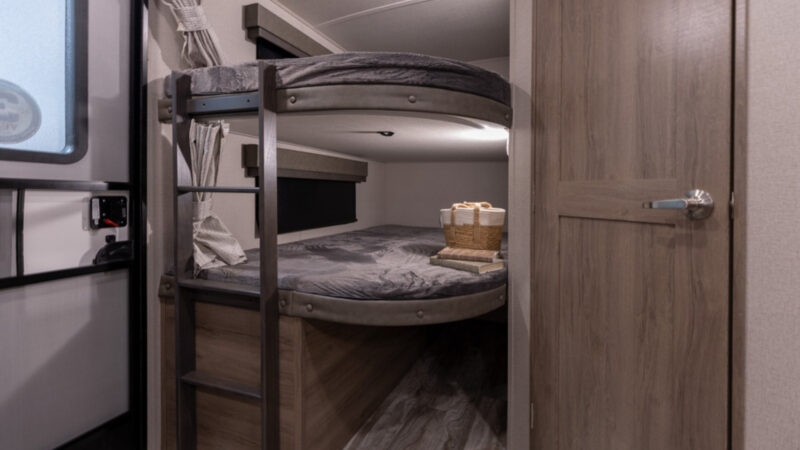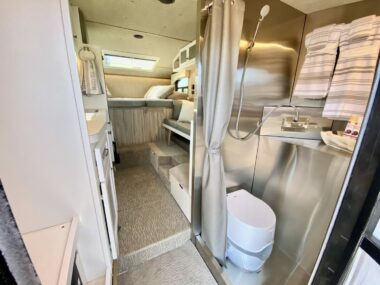Table of Contents Show
If you have a large family, you may be wondering what RVs are out there to accommodate your needs. You don’t want to have to convert a dinette or sofa every time you go camping. A bunkhouse travel trailer may be a great option.
Travel trailers are the least expensive RVs, and a bunkhouse will give your kids their own sleeping space. Let’s look at why you might want to consider taking some tours of a few models. A bunkhouse travel trailer may just be in your future!
What Is a Bunkhouse Travel Trailer?
A bunkhouse travel trailer is a towable RV with a bunkhouse.
It’s pulled by a ball and hitch secured to the bumper of another vehicle.
Most often, that vehicle will be a truck because bunkhouse travel trailers tend to be longer and heavier than other travel trailers.
Usually, it’s a three-quarter-ton (2500/250) or one-ton truck (3500/350) to manage the load more easily.
Not all bunkhouse travel trailers are longer and heavier, but most are.
Models that aren’t have eliminated other amenities like a sofa or a dinette to keep the same length.
However, it will have room for bunk beds.
So if you have a quarter-ton truck (1500/150) and want to be able to pull a bunkhouse travel trailer with it. Just know you’ll probably be giving up room in the living space.
Sometimes a bunkhouse is a completely separate room with a door. Other times, there are two, three, or four bunk beds.
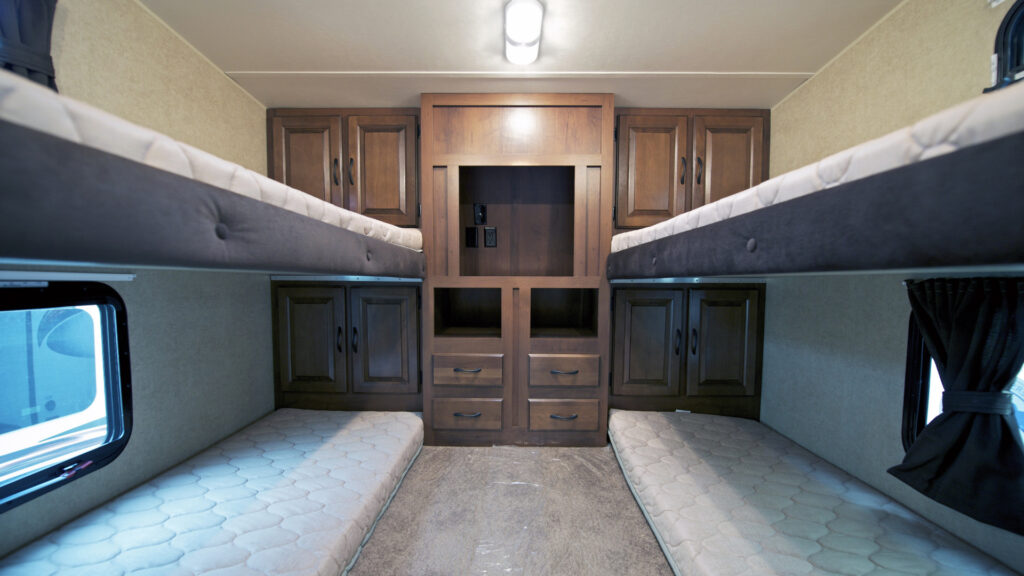
There may be a sofa, small dinette, or entertainment center, depending on the layout.
Usually, there’s a wardrobe or drawers for storage.
Other models only have bunk beds in the unit. They aren’t enclosed in a room or set apart from the rest of the living space with a door.
However, they usually have a curtain to close off the space around the bunk bed for some privacy.
These floor plans don’t offer the same storage space or privacy as a bunkhouse, but they work well for weekenders who just need a place for their kids to sleep for a couple of nights.
What Size Are the Bunk Beds for Trailers?
Unfortunately, there’s no set standard for bunk beds in travel trailers. The measurements aren’t all over the place, but they can vary based on the design.
Even within the same unit, one bunk bed can measure 30 inches by 74 inches, and another can measure 39 inches by 74 inches.
An example of that is the Jayco Eagle HT 312BHOK. Most commonly, the bunk beds will measure 28 inches to 35 inches in width and 75 inches to 80 inches in length.
The double-over-double bunk beds will be larger. For example, the bunks measure 47 inches by 76 inches in the Grand Design Imagine 2400BH.
Two smaller children could possibly share a double bunk bed. If you’re looking to use your standard twin or double sheets from your house, you’ll find neither will fit.
It might be best for the kids to sleep in sleeping bags on a weekend camping trip.
Pro Tip: Since bunk mattresses are sometimes not a standard size you will need a custom mattress. Don’t worry though, it’s easier than you think. See where to get the best custom RV bunk mattress.
What to Look for in a Bunkhouse Travel Trailer
When looking at bunkhouse travel trailers, it’s very important to understand your camping style.
If you plan to go to the beach for week-long trips or plan on camping for extended periods as you travel the country, having a separate bunkhouse room may be a better option than having bunk beds.
On the other hand, if you’re just taking the family out for a couple of weekend camping trips, the simple bunk beds without an enclosed room should meet your needs.
Layout
The floor plan is one of the most critical decisions to ensure an enjoyable camping experience.
If you get the floor plan wrong, it could cause huge frustrations.
Maybe you have young children and don’t want them sleeping at the opposite end of the travel trailer in a separate room.
Having a more open floor plan with the bunk beds near the living space may be better for you.
If you have pre-teens who crave privacy, you may constantly hear complaints if you don’t go with a separate bunkhouse floor plan.
But the bunkhouse or bunk bed decision isn’t the only important one. If you go with the bunkhouse, make sure it accommodates your children’s needs.
Some beds are wider and provide more sleeping space. If you have older elementary or middle school-age kids, the larger sleeping space makes sense.
And, if the bunkhouse has a dinette instead of a sofa, will it be used?
Or will it just accumulate stuff? If you need to convert that space to another bed, is it worth just finding a different bunkhouse that already has three beds instead?
Make sure there is storage space that’s actually usable.
If the only storage is underneath the bunk beds, it could be difficult and annoying to lift the mattress and everything else on the bed to get to it.
If you plan on traveling for long periods, having clothing storage is essential.
Where will your kids store their clothes and toys?
The space inside the room needs to accommodate the needs of your kids.
Keep in Mind: Does your child love RVs just as much as you do? We found the 7 best camper themed toys your kids will love!
Sleeping Capacity
Although many RVers renovate their rigs, it can be easier to find a layout that works for you.
So, you don’t have to invest the time or money in modifications.
However, if you have more than three or four kids, you may have to renovate to create adequate sleeping spaces.
Some bunkhouses provide a top and bottom bunk only.
Or, sometimes, the bottom space has a sleeper sofa instead of a bunk bed.
The other side of the room then has an entertainment center with storage space.
Some bunkhouses provide an additional bunk bed for three sleeping spaces on top of the entertainment center.
Larger bunkhouses have opposing slides and move the storage space to the rear center of the room.
They also feature two bunk beds on both sides. Some of the largest bunkhouse spaces keep the entertainment center on the side with a bunk bed on top of it.
Then the rear center space has two additional bunks beds while the opposite side has two bunk beds or a flip-up bunk over a sofa.
These floor plans provide sleeping for five or six kids.
When choosing a bunkhouse travel trailer, everyone needs to have their own sleeping space.
That doesn’t necessarily mean everyone must have individual beds. However, they need to have a space they can call their own.
It’s also possible for tri-fold sofas and dinettes to convert into additional sleeping spaces if needed.
Although not ideal because it can be cumbersome to do repeatedly, these options do create more sleeping areas.
Keep in mind the size of your family so that you pick the best floor plan with the right sleeping capacity.
Cargo Carrying Capacity
Something that many families don’t consider when purchasing a bunkhouse travel trailer is the cargo carrying capacity (CCC).
This is the amount of weight the RV can safely hold. It’s important to know the gross vehicle weight rating (GVWR) to make sure you have a vehicle with the towing capacity to pull the trailer.
But it’s just as important to know the CCC, so you don’t exceed the recommended weight, thus risking frame damage.
The more you camp, the more CCC you want to have. If you travel full-time, you probably don’t want less than 2,000 lbs of CCC because you’ll need more items than a weekender.
Once you load up all of your dishes, add a washer and dryer, put clothes into all the drawers, and get the kids’ toys packed away, you’d be surprised how much weight you’ve added to your rig.
If you’re taking your camper out a few times a year just to a local campground for the weekend, you won’t be loading as many things, so you can get by with a smaller CCC.
But regardless of what the CCC is, it’s very important to stay within that limit.
There’s a reason the manufacturer gave that particular bunkhouse travel trailer that weight limit. Overloading it is not worth the risk.
To make sure you’re within the GVWR and CCC of the unit, always weigh your RV at least a couple of times a year.
CAT scales are available all across the country at truck stops, so find one near your location to make sure you’re not over the limits set by the manufacturer.
The Best Bunkhouse Travel Trailers on the Market
Below are five bunkhouse trailer options that provide different floor plans to accommodate different camping lifestyles.
Three have a separate bunkhouse room, while two offer bunk beds out in the open. Some feature campside windows, a kitchen island, both a sofa and dinette in the living space, or an outdoor kitchen.
Depending on your needs, you’ll likely find one that works for you.
Grand Design Imagine 2400BH
MSRP: Starting around $50,800
Sleeps: Four to six
This Grand Design Imagine 2400BH features a queen bed in the front primary bedroom and double over double bunk beds in the rear of the unit.
There’s no bunkhouse room, but there’s bike storage underneath the bottom bunk bed.
The bathroom is next to the bunk beds. The living space includes a U-shaped dinette you could convert into another sleeping area.
Measuring 28 feet 11 inches and having a CCC of around 1,770 lbs, this bunkhouse travel trailer has a GVWR of 7,495 lbs.
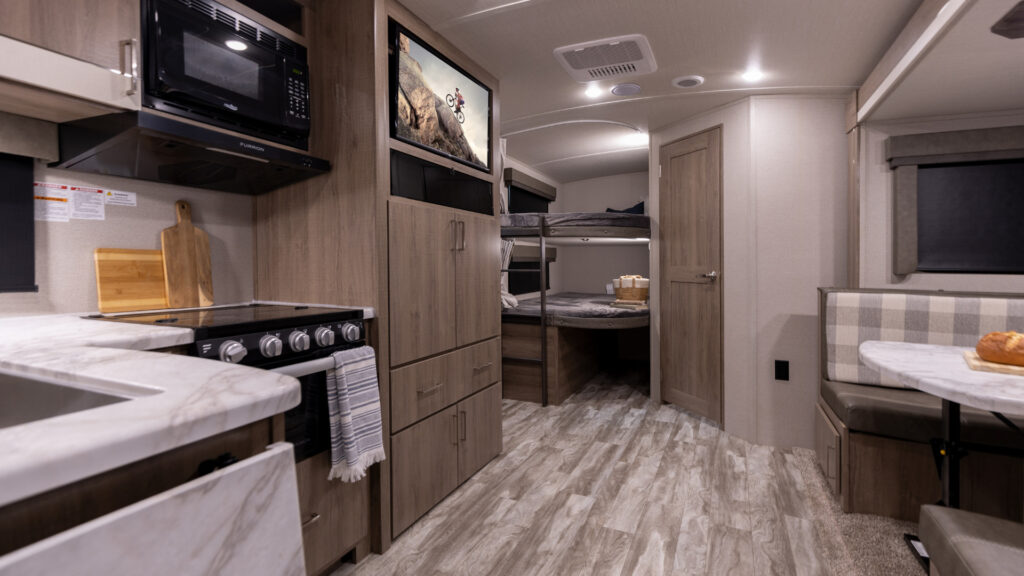
Coachmen Apex Ultra Lite 300BHS
MSRP: Starting around $53,000
Sleeps: Five to seven
This Coachmen Apex Ultra Lite 300BHS features a queen bed in the front primary bedroom and two bunk beds in the rear bunkhouse room.
There is also a futon for additional sleeping space directly across from an entertainment center. There is both a sofa and booth dinette in the living space.
Measuring 34 feet 5 inches and having a CCC of around 1,625 lbs, this bunkhouse travel trailer has a GVWR of 7,600 lbs.
Although not much heavier than the Imagine, the Coachmen Apex Ultra Lite is much longer because of the added bunkhouse room.
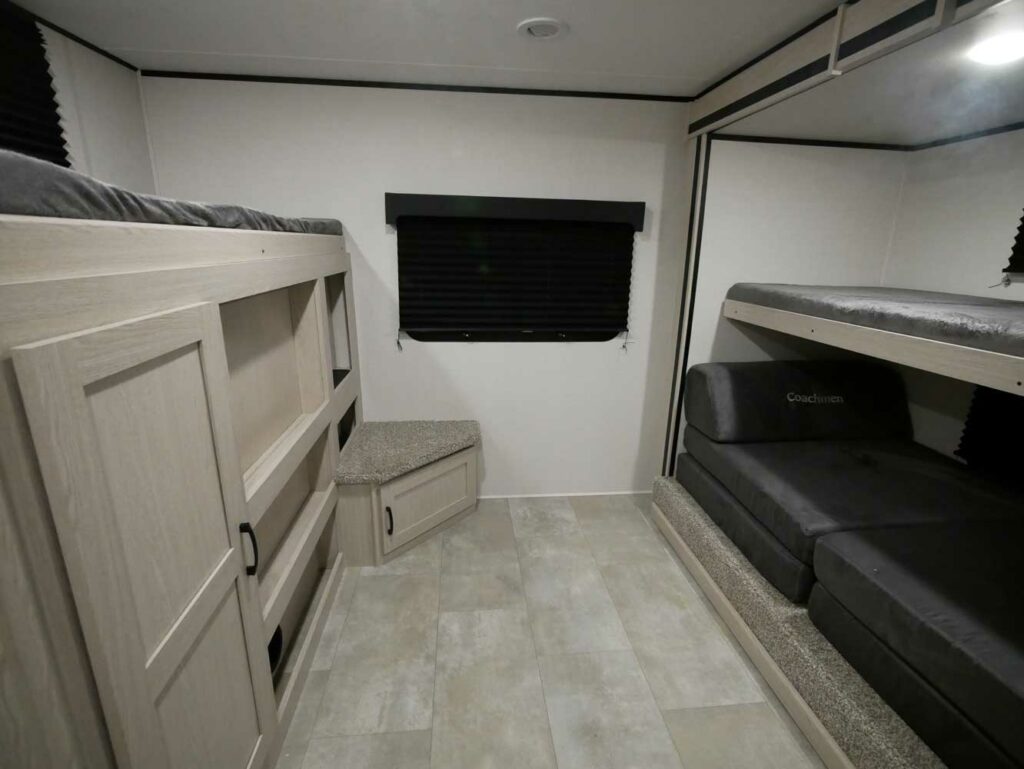
Cruiser Embrace EL310
MSRP: starting around $62,000
Sleeps: 4-7
This Cruiser Embrace EL310 features a king-sized sliding bed in the front primary bedroom and two bunk beds in the rear bunkhouse room.
There are gaming chairs under one bunk bed that sit directly across from an entertainment center.
There is a sofa and booth dinette in the living space that sit across from the kitchen area.
Two separate entry doors lead into the camper, one opens directly into the bathroom, and one opens directly into the living space.
Measuring 36 feet 5 inches and having a CCC of around 2,500 lbs, this bunkhouse travel trailer has a GVWR of 9,740 lbs.
It has a huge amount of CCC, but it’s also one of the longest and heaviest units on this list.
Keep this in mind when choosing a tow vehicle.
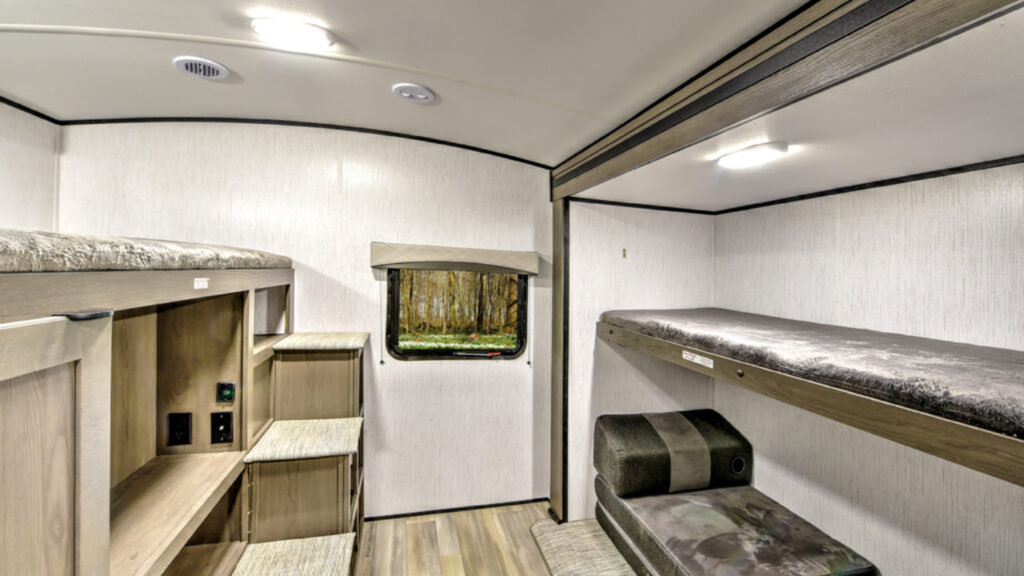
East to West Alta 2900KBH
MSRP: Starting around $45,000
Sleeps: Fout to eight
This is a slightly different floor plan from the Grand Design Imagine. This East to West Alta 2900KBH also has open double over double bunk beds.
In this unit, they’re situated directly in the rear of the camper behind the tri-fold sofa.
There’s storage below the second bunk bed and a small side wardrobe.
The front main bedroom features a king bed, and the dinette and pantry are across from the kitchen area.
This layout creates an L-shaped living space. Measuring 33 feet 11 inches and having a CCC of around 2,740 lbs, this bunkhouse travel trailer has a GVWR of 9,650 lbs.
The CCC of the East to West Alta 2900KBH is the largest of any model on this list.
Pro Tip: A travel trailer may not be the right option for you! Before you make your decision, check out these top 5 regrets of buying a travel trailer.
Jayco Eagle HT 312BHOK
MSRP: Starting around $76,000
Sleeps: Four to eight
This Jayco Eagle HT 312BOK features a queen bed in the front main bedroom and two bunk beds in the rear bunkhouse room.
A tri-fold sofa under one bunk bed sits directly across from an entertainment center.
The living space features a tri-fold sofa and booth dinette under campside windows.
There’s also a fireplace, kitchen island, and storage hutch in this unit.
Measuring 38 feet 9 inches and having a CCC of around 1,900 lbs, this bunkhouse travel trailer has a GVWR of 11,400 lbs.
Although there is not much CCC for this size rig, the Jayco Eagle HT 312BHOK offers the most space of all of the units on this list.
It’s also the longest and heaviest, so keep that in mind when choosing a tow vehicle.
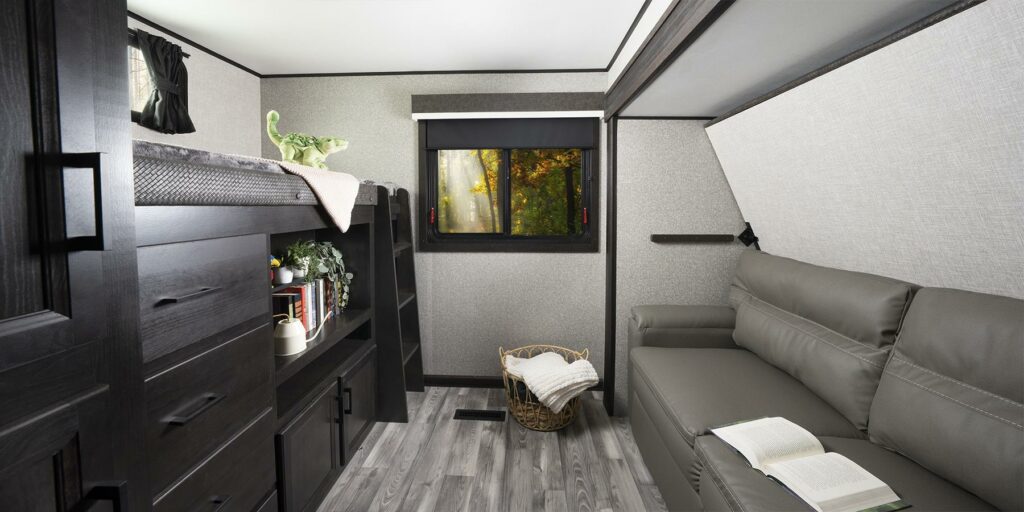
Bring the Whole Family With a Bunkhouse Travel Trailer
A bunkhouse travel trailer is a great option, whether you’re grandparents looking for a camper to bring your grandkids along one weekend or a family of five looking for space to accommodate everyone. Travel trailers are less expensive than fifth wheels or motorized RVs, and the added bunk beds create sleeping space for everyone.
If you haven’t toured a few models yet, head out to your nearest dealership and walk through a Grand Design or Jayco. Think about which layout works best for you while also keeping in mind each unit’s sleeping capacity and cargo-carrying capacity. Find the bunkhouse travel trailer that fits your needs, and then start making memories!




